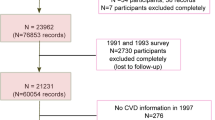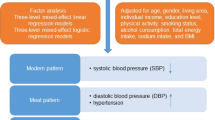Abstract
Background:
The frequency of spicy food intake has recently been associated with a reduced risk of mortality in the Chinese population. This study aimed to prospectively examine the association between chilli intake and the incidence of overweight/obesity in a Chinese adult population.
Methods:
Adults aged 20–75 years in the China Health and Nutrition Survey were followed between 1991 and 2011. Dietary data were collected during home visits using a 3-day food record in 1991, 1993, 1997, 2000, 2004, 2006, 2009 and 2011. Cox regression was used in the analysis. Overweight/obesity was defined as body mass index ⩾25 kg m−2.
Results:
A total 12 970 adults were followed for a median of 9 years. During 126 884 person-years of follow-up, 3203 subjects developed overweight/obesity. The absolute incidence rate of overweight/obesity was 26.4, 22.3, 24.4 and 20.5 per 1000 person-years among those who consumed no chilli or 1–20, 20.1–50, ⩾50.1 g per day, respectively. Chilli consumption was therefore inversely associated with the incidence of overweight/obesity. After adjusting for age, gender, energy and fat intake, smoking, alcohol drinking and physical activity, those whose cumulative average chilli intake was 0, 1–20, 20.1–50 and ⩾50.1 g per day had a hazard ratio for overweight/obesity of 1.00, 0.81 (95% confidence interval=0.73–0.89), 0.77 (0.69–0.86) and 0.73 (0.63–0.84); P for trend <0.001, respectively. There was no interaction between chilli intake and gender, income, education and residence (urban/rural) in relation to the risk of overweight/obesity.
Conclusions:
Chilli intake is inversely associated with the risk of becoming overweight/obese in Chinese adults.
This is a preview of subscription content, access via your institution
Access options
Subscribe to this journal
Receive 12 print issues and online access
$259.00 per year
only $21.58 per issue
Buy this article
- Purchase on Springer Link
- Instant access to full article PDF
Prices may be subject to local taxes which are calculated during checkout
Similar content being viewed by others
References
Rozin P, Schiller D . The nature and acquisition of a preference for chili pepper by humans. Motiv Emot 1980; 4: 77–101.
Astrup A, Kristensen M, Gregersen NT, Belza A, Lorenzen JK, Due A et al. Can bioactive foods affect obesity? Ann N Y Acad Sci 2010; 1190: 25–41.
Lv J, Qi L, Yu C, Yang L, Guo Y, Chen Y et al. Consumption of spicy foods and total and cause specific mortality: population based cohort study. BMJ 2015; 351: h3942.
Tremblay A, Arguin H, Panahi S . Capsaicinoids: a spicy solution to the management of obesity? Int J Obes 2016; 40: 1198–1204.
Fokkens W, Hellings P, Segboer C . Capsaicin for rhinitis. Curr Allergy Asthma Rep 2016; 16: 1–5.
Wu H, Wei M, Zhang Q, Du H, Xia Y, Liu L et al. Consumption of chilies, but not sweet peppers, is positively related to handgrip strength in an adult population. J Nutr Health Aging 2016; 20: 546–552.
Lopez-Carrillo L, Hernandez Avila M, Dubrow R . Chili pepper consumption and gastric cancer in Mexico: a case-control study. Am J Epidemiol 1994; 139: 263–271.
Whiting S, Derbyshire EJ, Tiwari B . Could capsaicinoids help to support weight management? A systematic review and meta-analysis of energy intake data. Appetite 2014; 73: 183–188.
Janssens PL, Hursel R, Martens EA, Westerterp-Plantenga MS . Acute effects of capsaicin on energy expenditure and fat oxidation in negative energy balance. PLoS ONE 2013; 8: e67786.
Ludy MJ, Moore GE, Mattes RD . The effects of capsaicin and capsiate on energy balance: critical review and meta-analyses of studies in humans. Chem Senses 2012; 37: 103–121.
Yoshioka M, St-Pierre S, Drapeau V, Dionne I, Doucet E, Suzuki M et al. Effects of red pepper on appetite and energy intake. Br J Nutr 1999; 82: 115–123.
Ludy MJ, Mattes RD . The effects of hedonically acceptable red pepper doses on thermogenesis and appetite. Physiol Behav 2011; 102: 251–258.
Sun D, Lv J, Chen W, Li S, Guo Y, Bian Z et al. Spicy food consumption is associated with adiposity measures among half a million Chinese people: the China Kadoorie Biobank study. BMC Public Health 2014; 14: 1293.
Li J, Wang R, Xiao C . Association between chilli food habits with iron status and insulin resistance in a Chinese population. J Med Food 2014; 17: 472–478.
Zhai FY, Du SF, Wang ZH, Zhang JG, Du WW, Popkin BM . Dynamics of the Chinese diet and the role of urbanicity, 1991-2011. Obes Rev 2014; 15 (Suppl 1): 16–26.
Popkin BM, Du S, Zhai F, Zhang B . Cohort Profile: The China Health and Nutrition Survey—monitoring and understanding socio-economic and health change in China, 1989-2011. Int J Epidemiol 2010; 39: 1435–1440.
Yao M, McCrory MA, Ma G, Tucker KL, Gao S, Fuss P et al. Relative influence of diet and physical activity on body composition in urban Chinese adults. Am J Clin Nutr 2003; 77: 1409–1416.
Hu FB, Stampfer MJ, Rimm E, Ascherio A, Rosner BA, Spiegelman D et al. Dietary fat and coronary heart disease: a comparison of approaches for adjusting for total energy intake and modeling repeated dietary measurements. Am J Epidemiol 1999; 149: 531–540.
Yan S, Li J, Li S, Zhang B, Du S, Gordon-Larsen P et al. The expanding burden of cardiometabolic risk in China: the China Health and Nutrition Survey. Obes Rev 2012; 13: 810–821.
Shi Z, Taylor AW, Riley M, Byles J, Liu J, Noakes M . Association between dietary patterns, cadmium intake and chronic kidney disease among adults. Clin Nutr 2017; S0261-5614: 31366–31368.
Yoshioka M, Doucet E, Drapeau V, Dionne I, Tremblay A . Combined effects of red pepper and caffeine consumption on 24 h energy balance in subjects given free access to foods. Br J Nutr 2001; 85: 203–211.
Shi Z, Hu X, Yuan B, Hu G, Pan X, Dai Y et al. Vegetable-rich food pattern is related to obesity in China. Int J Obes (Lond) 2008; 32: 975–984.
Westerterp-Plantenga MS, Smeets A, Lejeune MP . Sensory and gastrointestinal satiety effects of capsaicin on food intake. Int J Obes 2005; 29: 682–688.
Smeets AJ, Janssens PL, Westerterp-Plantenga MS . Addition of capsaicin and exchange of carbohydrate with protein counteract energy intake restriction effects on fullness and energy expenditure. J Nutr 2013; 143: 442–447.
Kentish SJ, Page AJ . Plasticity of gastro-intestinal vagal afferent endings. Physiol Behav 2014; 136: 170–178.
Kentish SJ, Frisby CL, Kritas S, Li H, Hatzinikolas G, O'Donnell TA et al. TRPV1 channels and gastric vagal afferent signalling in lean and high fat diet induced obese mice. PLoS ONE 2015; 10: e0135892.
Wang X, Miyares RL, Ahern GP . Oleoylethanolamide excites vagal sensory neurones, induces visceral pain and reduces short-term food intake in mice via capsaicin receptor TRPV1. J Physiol 2005; 564 (Pt 2): 541–547.
Vyklicky L, Novakova-Tousova K, Benedikt J, Samad A, Touska F, Vlachova V . Calcium-dependent desensitization of vanilloid receptor TRPV1: a mechanism possibly involved in analgesia induced by topical application of capsaicin. Physiol Res 2008; 57 (Suppl 3): S59–S68.
Matsumoto T, Miyawaki C, Ue H, Yuasa T, Miyatsuji A, Moritani T . Effects of capsaicin-containing yellow curry sauce on sympathetic nervous system activity and diet-induced thermogenesis in lean and obese young women. J Nutr Sci Vitaminol (Tokyo) 2000; 46: 309–315.
Clegg ME, Golsorkhi M, Henry CJ . Combined medium-chain triglyceride and chilli feeding increases diet-induced thermogenesis in normal-weight humans. Eur J Nutr 2013; 52: 1579–1585.
Yoshioka M, Lim K, Kikuzato S, Kiyonaga A, Tanaka H, Shindo M et al. Effects of red-pepper diet on the energy metabolism in men. J Nutr Sci Vitaminol (Tokyo) 1995; 41: 647–656.
Cichewicz RH, Thorpe PA . The antimicrobial properties of chile peppers (Capsicum species) and their uses in Mayan medicine. J Ethnopharmacol 1996; 52: 61–70.
Acknowledgements
This research uses data from China Health and Nutrition Survey (CHNS). We thank the National Institute for Nutrition and Health, China Center for Disease Control and Prevention, Carolina Population Center (P2C HD050924, T32 HD007168), the University of North Carolina at Chapel Hill, the NIH (R01-HD30880, DK056350, R24 HD050924 and R01-HD38700) and the NIH Fogarty International Center (D43 TW009077, D43 TW007709) for financial support, for the CHNS data collection and analysis files from 1989 to 2015 and future surveys, and the China-Japan Friendship Hospital, Ministry of Health for support for CHNS 2009, Chinese National Human Genome Center at Shanghai since 2009 and Beijing Municipal Center for Disease Prevention and Control since 2011.
Author contributions
ZS contributed to the conception, analysis and interpretation of data; drafting of the report; and have given approval of the final version for publication. AWT, MR and AP contributed to the analysis and interpretation of the data, commented on the report, revising the manuscript and approving the final version for publication.
Author information
Authors and Affiliations
Corresponding author
Ethics declarations
Competing interests
The authors declare no conflict of interest.
Additional information
Supplementary Information accompanies this paper on International Journal of Obesity website
Supplementary information
Rights and permissions
About this article
Cite this article
Shi, Z., Riley, M., Taylor, A. et al. Chilli consumption and the incidence of overweight and obesity in a Chinese adult population. Int J Obes 41, 1074–1079 (2017). https://doi.org/10.1038/ijo.2017.88
Received:
Revised:
Accepted:
Published:
Issue Date:
DOI: https://doi.org/10.1038/ijo.2017.88
This article is cited by
-
Effects of spicy food consumption on overweight/obesity, hypertension and blood lipids in China: a meta‐analysis of cross-sectional studies
Nutrition Journal (2023)
-
Association between spicy foods consumption and cardiovascular disease risk factors: Guangzhou Biobank Cohort Study
BMC Public Health (2022)
-
Spicy food consumption is associated with abdominal obesity among Chinese Han population aged 30–79 years in the Sichuan Basin: a population-based cross-sectional study
BMC Public Health (2022)
-
Sex differences in changes in BMI and blood pressure in Chinese school-aged children during the COVID-19 quarantine
International Journal of Obesity (2021)
-
Mediation effect of body mass index on the association between spicy food intake and hyperuricemia in rural Chinese adults: the Henan rural cohort study
BMC Public Health (2020)



